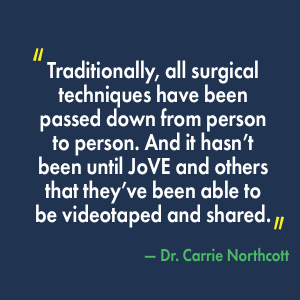Summary
Researchers at Michigan State University used a JoVE video article to streamline and improve the teaching of a complex catheterization lab procedure — resulting in a 90-100 percent initial attempt success rate for the protocol — and a cumulative annual savings of $13,650 in lab costs.

Challenge
Noted scientist Dr. Carrie Northcott was principal investigator at the Department of Pharmacology and Toxicology at Michigan State University, where she oversaw a lab of some nine student researchers. These students all needed to be competent in the lab’s standard femoral arterial catheter implantation technique. However, even when Dr. Northcott demonstrated the process first-hand, the students found adoption difficult. And the annual rotation of students through the lab demanded regular, time-consuming, and expensive training to keep the team current on the catheter protocol.
The protocol training impacted the lab’s human and financial resources. That was because:
- To reach the prescribed catheterization time limit (20 to 30 minutes per procedure) typically required eight attempts per learner
- The teaching success rate was variable, often below 40 percent
- Each trial attempt cost $50 in consumable materials/lab animals
Solution
To aid in teaching, Dr. Northcott self-published her own custom training video. Students repeatedly watched this, and learning accelerated somewhat. Dr. Northcott and her colleague, MSU Core Research Facilities Manager Brian Jespersen, were sold on the idea of using videos to teach — but decided they needed professional assistance for it.
To that end, they published the catheter implant technique in JoVE. “The professional quality and the knowledge of filming detailed experimental procedures that JoVE brought to it wasn’t something that we could do [replicate] in a home version,” says Dr. Northcott. “The editing has made it very concise, detailed and clear to the viewer.”
Publishing in JoVE’s signature video-article format offered an unexpectedly wide range of opportunities to Dr. Northcott and Jespersen. They used the JoVE video to teach in the classroom and lab, and to share the technique with their colleagues. “We were able to reach a large audience [with JoVE],” says Dr. Northcott. “We used it in all different types of formats.”
 Dr. Carrie Northcott
Dr. Carrie Northcott
Results
Introducing JoVE’s video to teach the protocol offered quantifiable savings, in both training time and laboratory costs. Most importantly, it increased the likelihood of a first-attempt implant success. “Initially it took multiple tries, whereas now when we teach this technique with the JoVE video, we have a success rate between 90 to 100 percent,” says Dr. Northcott.
It was possible to teach, in under three hours, a class of up to 15 people to successfully perform the implants. The reduced training time/expenses translated into performance and financial benefits, as follows:
- Student attempts to implant the catheter dropped from eight tries to just one
- This resulted in savings of $350 per lab tech (there are typically nine techs)
- Cumulatively, because of this, the lab annually saved $3,150
- There were also annual savings of $10,500-plus for Jespersen’s graduate level courses (each course included 10-14 new MSU students)
- Collectively, MSU saved some $13,650 annually
- Ultimately, the video procedure even helped in securing grant money

